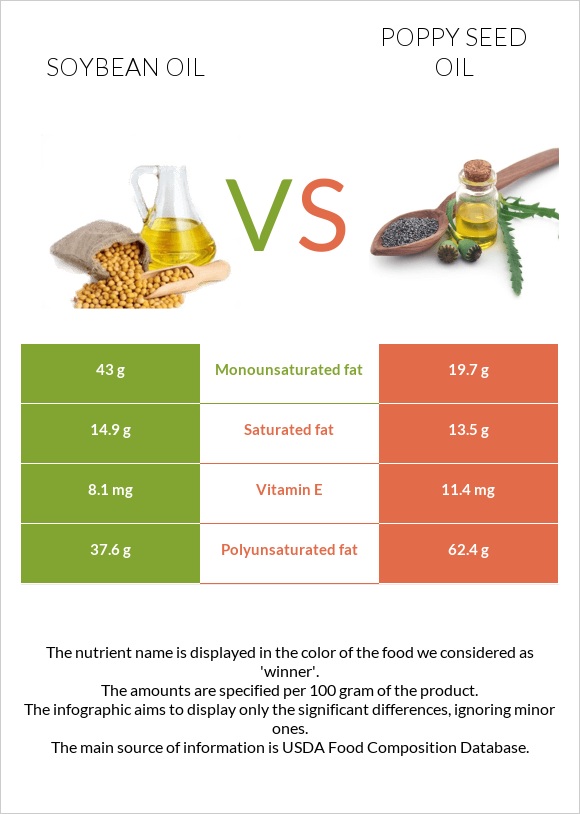Soybean oil vs. Poppy seed oil — In-Depth Nutrition Comparison
Compare
How are soybean oil and poppy seed oil different?
- Soybean oil is richer in monounsaturated fat, while poppy seed oil is higher in vitamin E and polyunsaturated fat.
- Poppy seed oil covers your daily need for vitamin E, 22% more than soybean oil.
- Soybean oil contains 2 times more monounsaturated fat than poppy seed oil. Soybean oil contains 43g of monounsaturated fat, while poppy seed oil contains 19.7g.
- Poppy seed oil is lower in saturated fat.
Oil, soybean, salad or cooking, (partially hydrogenated) and Oil, poppyseed types were used in this article.
Infographic

Infographic link
Mineral Comparison
Mineral comparison score is based on the number of minerals by which one or the other food is richer. The "coverage" charts below show how much of the daily needs can be covered by 300 grams of the food.
Vitamin Comparison
Vitamin comparison score is based on the number of vitamins by which one or the other food is richer. The "coverage" charts below show how much of the daily needs can be covered by 300 grams of the food.
| Contains more Vitamin KVitamin K | +∞% |
| Contains more Vitamin EVitamin E | +40.7% |
All nutrients comparison - raw data values
| Nutrient |  |
 |
DV% diff. |
| Polyunsaturated fat | 37.6g | 62.4g | 165% |
| Monounsaturated fat | 43g | 19.7g | 58% |
| Vitamin E | 8.1mg | 11.4mg | 22% |
| Vitamin K | 24.7µg | 21% | |
| Saturated fat | 14.9g | 13.5g | 6% |
| Calories | 884kcal | 884kcal | 0% |
| Fats | 100g | 100g | 0% |
| Choline | 0.2mg | 0% |
Macronutrient Comparison
Macronutrient breakdown side-by-side comparison
Protein:
0 g
Fats:
100 g
Carbs:
0 g
Water:
0 g
Other:
0 g
Protein:
0 g
Fats:
100 g
Carbs:
0 g
Water:
0 g
Other:
0 g
~equal in
Protein
~0g
~equal in
Fats
~100g
~equal in
Carbs
~0g
~equal in
Water
~0g
~equal in
Other
~0g
Fat Type Comparison
Fat type breakdown side-by-side comparison
Saturated fat:
Sat. Fat
14.9 g
Monounsaturated fat:
Mono. Fat
43 g
Polyunsaturated fat:
Poly. Fat
37.6 g
Saturated fat:
Sat. Fat
13.5 g
Monounsaturated fat:
Mono. Fat
19.7 g
Polyunsaturated fat:
Poly. Fat
62.4 g
| Contains more Mono. FatMonounsaturated fat | +118.3% |
| Contains more Poly. FatPolyunsaturated fat | +66% |
~equal in
Saturated fat
~13.5g




